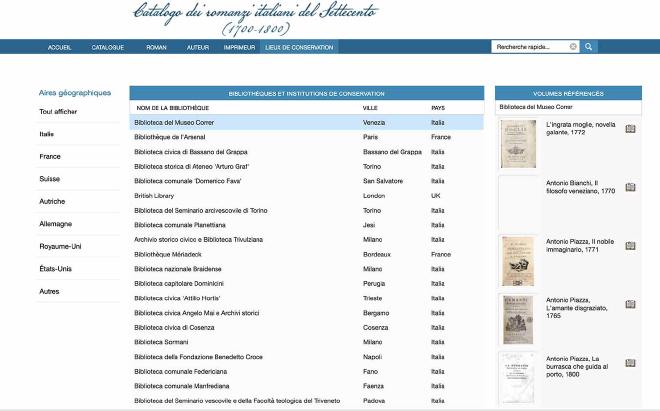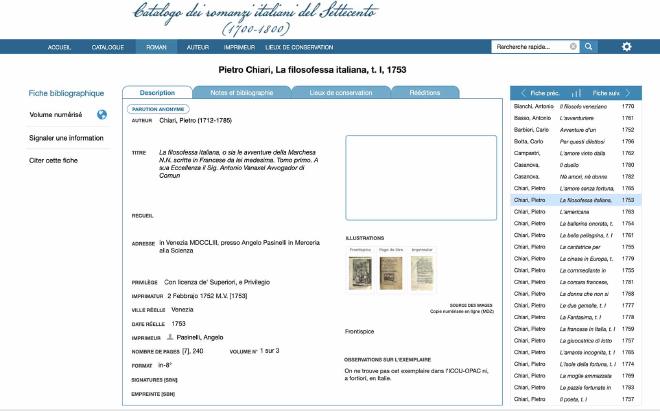Creating a New Catalogue of 18th Century Italian Novels #
Since 2021, thanks to a research grant from the Institut universitaire de France (IUF), I have undertaken to identify and catalogue the corpus of eighteenth-century Italian novels, furthering the pioneering bibliographical survey conducted by Giambattista Marchesi in 1903, corrected and expanded by Tatiana Crivelli a century later in 2002, with the aim of reconstructing a modern, reliable, up-to-date repertory for the use of scholars.

My project - which consists more specifically in a census of the princeps editions of Italian novels and their eighteenth-nineteenth-century reissues, accompanied by a list of the main Italian translations or reworkings of European novels, identifying their sources - might seem, if not impossible, at least complicated, as it requires examining and correcting a series of more or less reliable bibliographical data accumulated over decades, spread not only in numerous articles, essays, and encyclopaedia entries, but even in some cases reproduced in the OPACs of European libraries.
Giambattista Marchesi’s catalogue must therefore be revised, incorporating the progress of the most recent studies and launching a scrupulous bibliographical survey in European libraries, with the aim of checking every physical copy of every published novel, and photographing the title page, the frontispiece and the printing licence, when they exist. This work, which a few decades ago would have required infinite patience and a painstaking search from Venice to Naples, from Paris to Augsburg, is now made easier by the existence of computerised library catalogues and by the expansion of digital library catalogues, from Gallica to Google Books and the Internet Archive…
A Neglected Literary Heritage #

At this point, one might ask: but is it really worth taking an interest in the 18th century Italian novel? The novel as a literary genre was despised in Italy by the learned classes as early as the 18th century, then subsequently neglected by literary critics until the end of the 20th century and excluded from the national canon, despite enjoying great publishing success and wide distribution in 18th-century bookshops. Reconstructing the memory of this genre through a new exhaustive catalogue means not only rediscovering the vitality and fortune of the novel in 18th-century Italy, but also better understanding the mechanisms of cultural and literary transfers in 18th-century Europe, where texts circulated from one language to another, from one publisher to another, across borders, demonstrating an extraordinary malleability in adapting to the tastes and expectations of readers in every nation.
A Public Site in 2025 #

The implementation of the database and the development of the web interface for public consultation with FileMaker Pro are currently in progress. The opening of the public site, hosted by Huma-Num, is planned for the end of 2025 at this address: Catalogue des romans.
